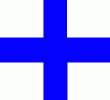|
Code International des Signaux Origine
|
International Code of Signals
|
|
|
|
||
| Le Code International des Signaux ne s'est pas créé en un seul jour. Les signaux qu'il utilise avaient été utlisés dans d'autres codes auparavent. Voici un récapitulatif des échanges sur le sujet sur FOTW-l de mars 2006. | |||||
|
Caractère
|
Signal
|
Origine
|
|||
|
A
|
 |
Rectangular version by Adm Vernon, RN, mid-18th century | |||
|
B
|
 |
Rectangular version from antiquity; swallowtail in Adm Russell, RN, 1691 | |||
|
C
|
 |
ICS 1934 | |||
|
D
|
 |
ICS 1934 Kemperfelt 1778 |
|||
|
E
|
 |
USN 1803 had R-B horizontal
Commodore David Porter's 1809 signal book had B-R horizontal as well as R-B. This flag (which could be flown either way up) was included in the signals used by Admiral Rodney (RN) in 1782. Echo is a flag that was used in Lord Howe's Signals and Instructions on the North America Station in 1776. [Facsimile] It was a combination that he considered unsatisfactory, and was not used in his later codes. |
|||
|
F
|
 |
A white flag pierced with a red lozenge was in Admiral Robert Digby's code of 1782. [Mariner's Mirror Feb 1953] | |||
|
G
|
 |
ICS 1934 | |||
|
H
|
 |
French Adm Duchuffault, 1780
This was also used by Rodney in 1782, but first appears in reversed colours (R-W) in Instructions issued by Admiral Russell (RN) in 1691. |
|||
|
I
|
 |
This flag first appears as 'H' in the British
Admiralty naval code of 1889, the The International Code of Signals as
revised in 1897 gives a yellow flag with a 'blue' ball.
With a blue ball, this was introduced in 1878 by Burney. [Gordon's FOTW] |
|||
|
J
|
 |
Marryat 1817 | |||
|
K
|
 |
Howe 1790 Kemperfelt 1778 |
|||
|
L
|
|
This flag first appears as 'F' in the British
Admiralty naval code of 1889, the Commercial Code of Signals of 1857
gives yellow and 'blue' quarterly.
With blue and yellow in Digby's code of 1782. [Mariner's Mirror Feb 1953] |
|||
|
M
|
 |
Duchaffault 1780 | |||
|
N
|
 |
Pennant form RN 1756; rectangular Duchaffault 1780 |
|||
|
O
|
 |
Nothing certain but a R-Y diagonal (orientation unknown) was included in the English Naval Instructions of 1673.
|
|||
|
P
|
 |
RN by 1756
Perhaps more like the years between 1756 and 1762? |
|||
|
Q
|
 |
RN by 1688
A plain yellow signal flag first appears in Boteler written in the early 1630's, and appears again in 1691. |
|||
|
R
|
 |
Marryat 1817 | |||
|
S
|
 |
USN 1812 | |||
|
T
|
 |
USN 1803 | |||
|
U
|
 |
Howe 1790
Kempenfelt 1780. [Mariner's Mirror Feb 1953] |
|||
|
V
|
 |
RN by 1689 | |||
|
W
|
 |
ICS by 1867
On a French Code Flag Signal Chart captured by HMS Fisguard in 1804. [Facsimile] |
|||
|
X
|
 |
Adm Hawke, RN, 1762 | |||
|
Y
|
 |
RN 1673
Howard M. Chapin, "Notes on the Early Development of the Designs in Marine Signal Flags," United States Naval Institute Proceedings, Vol. 53, No. 297 (Nov 1927), pp. 1191-1195, says that the 1673 Instructions introduced a flag with red and yellow diagonal stripes, as well as one with red and white diagonal stripes and another with red and white horizontal stripes. The two red and white ones were carried over to the 1689 instructions, but the red and yellow one wasn't. I don't have a copy of the Instructions themselves, just the Chapin article, so I can't verify his statement. |
|||
|
Z
|
 |
IC 1871 | |||
| Pour plus de renseignements lire les pages:
The allocation and use of ship identification signal codes for merchant ships to WWII |
|||||